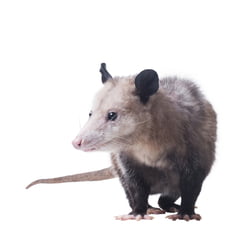Identification
- Colour Grey, with red, brown, or black hues
- Size Up to 55 cm
- Description Have elongated heads, pointed snouts, pink noses, and more than 50 sharp, serrated teeth. They also have defined whiskers, big, black eyes, leathery ears, short legs, and long, hairless tails.

How to identify Opossums
Typically grey in colour, opossum fur can also have red, brown, or black hues. Their heads are elongated, their snouts are pointed, and their mouths open quite wide to reveal over 50 sharp teeth. Other recognizable features include pink noses, defined whiskers, big, black eyes, leathery ears, short legs, and long, hairless tails. Opossums grow to sizes comparable to housecats, weighing between 2 and 6 kg and measuring as long as 55 cm.
Signs of an infestation
Homeowners may be alerted to opossum infestations by seeing the pest itself, noticing knocked-over trash cans, waking up to missing pet food, and even hearing them in the house. Opossums enter buildings in search of new denning sites and can cause damage to insulation and duct work. They also leave behind droppings as evidence of their presence. When infestations exist on private properties, residents may notice damaged lawns.
Opossums Removal
Trapping should only be done with the help of a trained pest professional. It’s illegal to relocate a trapped opossum in most areas, so calling for professional help keeps individuals from facing legal consequences. Orkin Canada’s wildlife and pest removal specialists can humanely trap and remove problem opossums in accordance with the law.
How to prevent Opossums from invading
Different methods of habitat modification and exclusion help reduce the possibility of attracting opossum infestations. For example, individuals should try eliminating overhanging trees, equipping garbage cans with tight-fitting lids, and bringing in pet food overnight to keep the pests at bay. Additionally, covering the holes under decks and porches with mesh wire limits available nesting options.
Habitat, Diet, and Life Cycle
Habitat
Highly adaptable, opossums can be found in a variety of habitats across North America. They are solitary by nature and prefer to live in dense woodlands close to bodies of water. As such, swamps, bogs, and marshes make ideal denning sites. Opossums that live in residential areas thrive in agricultural fields and private lawns with vegetable gardens.
Diet
Opossums are opportunistic feeders whose diets change depending on the season. They are omnivores and eat a variety of plant matter, fruits, seeds, grains, insects, earthworms, birds, and frogs. Additionally, opossums forage for carrion, garbage, and pet food left outdoors when other food sources are unavailable. Their strong jaws allow them to crush bones and shells, which is handy because opossums regularly need calcium and will eat skeletal remains to satisfy that need.
Life Cycle
Typical opossum litter sizes range from as few as 4 to as many as 25 joeys. As marsupials, the pests carry their young in pouches. When the babies are born, they only weigh between one and two tenths of a gram. Young opossums usually reach independence at about four months of age and become sexually mature soon after. Opossums typically live two years in the wild.
Commonly Asked Questions
Why do I have opossums?
Opossums are solitary, nocturnal marsupials who prefer to build their dens in thick woodlands close to bodies of water, like swamps, bogs, and marshes.
However, they can live in residential areas and sometimes enter buildings in search of new denning sites.
While they spend most of their time on the ground, opossums are adept climbers and use their prehensile tails as additional limbs to help them move through trees.
Opossums are opportunistic feeders and are attracted to plant matter, fruits, seeds, grains, insects, earthworms, birds, frogs, carrion, garbage, and pet food. Their strong jaws allow them to crush bones and shells, and they will eat skeletal remains to get the calcium they need.
How worried should I be about opossums?
Opossums frequently tip over trash cans to find food, steal from gardens, threaten the safety of pets, and attack chickens. They also damage insulation and duct work when entering the home to look for somewhere to build a den.
These pests also defecate on porches and decks, which can contribute to the spread of diseases, including leptospirosis, tularemia, spotted fever, tuberculosis, Chagas disease, and rabies. They can carry fleas, ticks, mites, and lice, which they can be passed on.
When threatened, opossums often play dead, but they are unpredictable wild animals and can bite if provoked or disturbed. It is is also illegal to relocate trapped opossums in most areas. To safely and humanely remove an opossum, you’ll need professional pest control services.
Other pests related to Opossums
100% Satisfaction or Money Back Guarantee
Resolving your pest problem is our #1 priority. If re-treatment is required, we'll provide immediate services at no extra cost. If your expectations are not met, we guarantee a full refund of your service payment.
Remove pests from your home, and stop them from coming back
We work hard to listen, understand and assess your unique situation. Request a free, no-obligation estimate today for a customized pest program that fits your needs.
Request a Free Home EstimateRequest a Free Business Consultation

